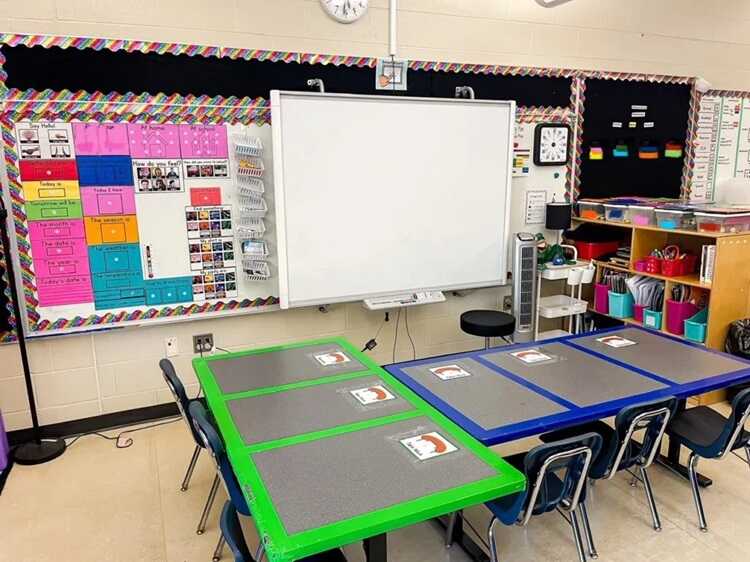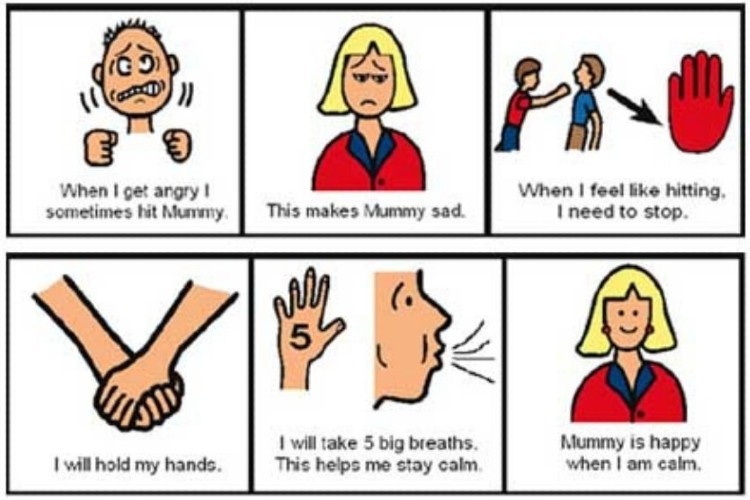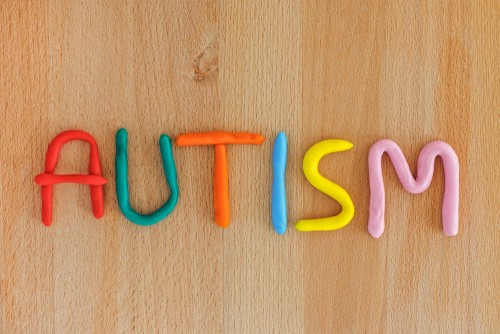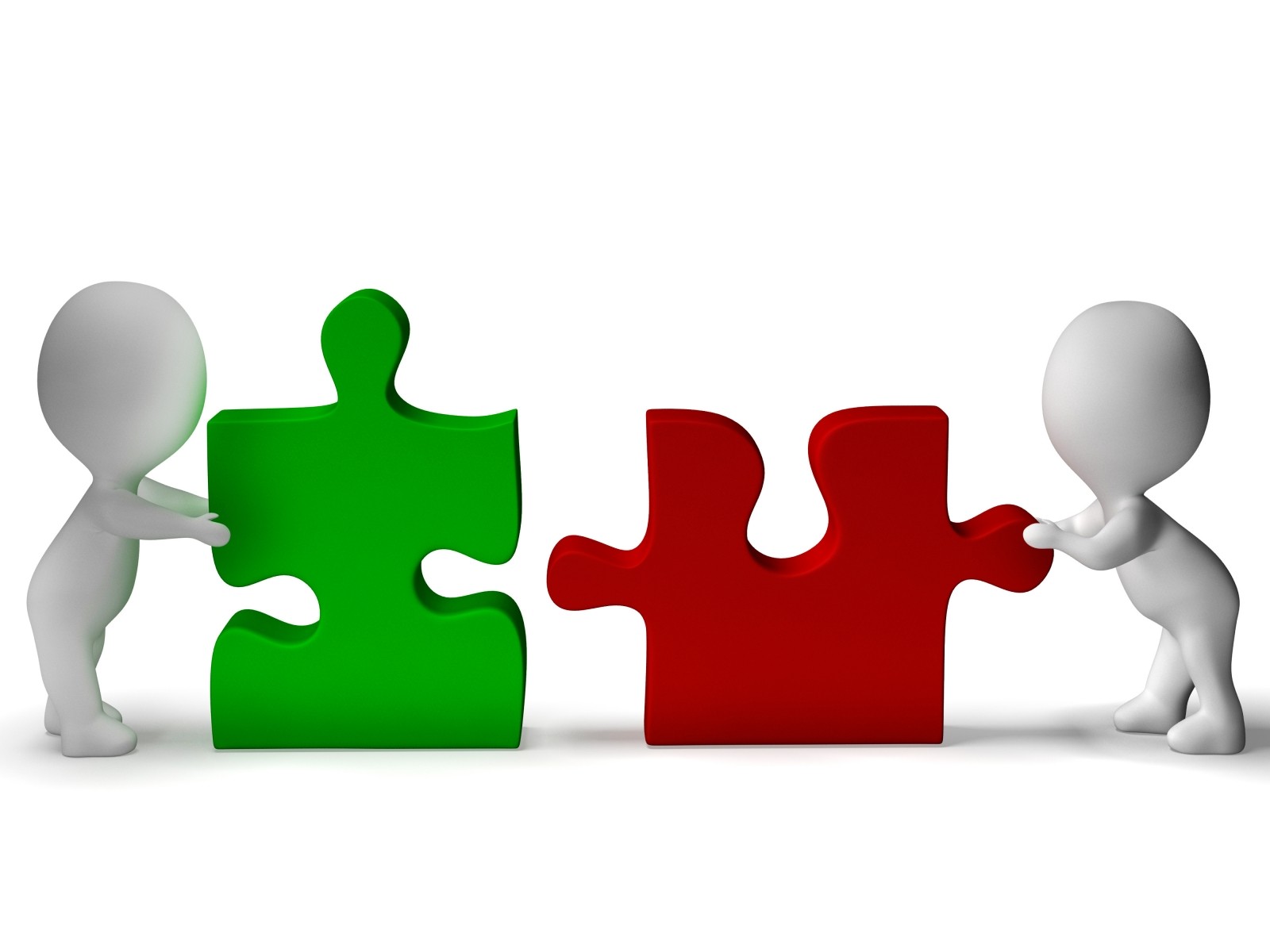Classroom Boundary Markers for Autistic Students
Boundary markers for autistic students are essential environmental supports that help clarify expectations and minimize confusion in the classroom. Children with autism thrive in a structured and predictable environment. Implementing boundary markers for autistic students helps establish routines early on and maintains consistency. In a world that is constantly changing, these routines provide comfort and support to students on the autism spectrum.
We will be covering
- What is a Boundary Marker?
- Examples of Boundary Markers
- Boundary Marker for Autistic Students Best Practices
- Boundary Markers in a Self-Contained Classroom
What is a boundary marker?
Boundary markers for autistic students are physical or environmental supports that help those with autism spectrum disorder (ASD) understand expectations for various activities and settings. Boundary markers can be either:
- Color-Coded Areas use different colors to signify various activities within the same space or,
- Sectioned-Off Areas indicate where students should be during activities promoting organization and focus or a combination of both.

Examples of boundary markers
Some common, effective examples of boundary markers include:
- Visual Cues: Implement pictures, charts, or timers to signal when a boundary is established, aiding comprehension for autistic students.
- Colored Tape or Rugs: Use colored tape or rugs to delineate specific areas on the floor, guiding students on where they should be.
- Name Tags: Employ name tags or tape to designate seating arrangements, making it clear where each student is expected to sit.
- Colored Tablecloths: Utilize colored tablecloths to differentiate between various activities when multiple tasks are being conducted in the same space.
- Break Cards: Provide break cards that allow students to request a pause from activities, tasks, or social interactions, empowering them to manage their needs.
- Line-Up Markers: Use visual floor markers to help students remember where to stand when lining up, promoting organization and structure.

Boundary Marker for Autistic Students Best Practices
Educators and specialists agree on several strategies when creating boundary markers as part of a learning environment for autistic students.
To further assist autistic students in navigating boundaries, consider these best practices:
- Clear Communication that focuses on necessary tasks: Use simple language to ensure instructions are easily understood. Prioritize what needs to be accomplished, aiding clarity for students.
- Consistent Rules: Maintain stable rules and consequences to foster a predictable environment.
- Set Outer Limits: Clearly define the boundaries within which students can operate.
- Respect Personal Space: Be mindful of personal boundaries, which can greatly benefit autistic students.
- Social Stories and Role-Playing: Incorporate social stories and role-playing to prepare students for different scenarios.
- Positive Reinforcement: Encourage and reinforce positive behavior to motivate students.
- Modeling Behavior: Demonstrate appropriate behavior to provide a clear example for students to follow.
- Flexibility: Be willing to adjust boundaries as needed to accommodate individual student needs.
- Involve Students: Engage students in boundary-setting to promote understanding and ownership.
- Create Household Goals: Establish goals for the entire household to foster consistency.
- Allow Time for Learning and Growth: Provide students the time they need to adapt and thrive within established boundaries.
When boundaries and markers begin to show effectiveness with students with ASD, rewards for appropriately following the supports should be utilized. That is, when a student correctly follows them, they should be provided with social praise or other types of rewards.

Boundary Markers in a Self-Contained Classroom
When considering boundary markers for autistic students, incorporating best practices in a self-contained classroom allows educators to design the space with the specific needs of these students in mind. This more intensive educational environment helps personalize learning while increasing social interaction and creating a sense of belonging for students with diverse needs.
A self-contained classroom is generally explained as a classroom for special learners in which all members are students with special needs. The classroom may be part of a general education school building or a separate facility for students with special needs. Some classrooms operate as fully self-contained and have students stay in the room for the entire day. On the other hand, other self-contained classroom models have instruction in the room but then go to lunch, specials, recess, etc., with their general education peers.
Self-contained classes usually have no more than ten students and are typically led by a certified teacher. Students in the class are often assisted by a Para-educator who is also there to provide additional support during instruction. These classes enhance students’ ability to learn by limiting the class size and addressing their special needs with smaller groups, individualized instruction, and a flexible but nurturing environment.
When preparing a self-contained classroom, the following strategies help incorporate boundary markers for autistic students:
- Structure Your Day: Children with autism thrive in a structured and predictable environment. Establish routines early and maintain consistency. Clearly define routines and review them daily. If deviations from the schedule are necessary, provide warnings as soon as possible to help students adjust.
- Use Visuals: A picture speaks a thousand words! Incorporate visuals whenever possible, as they greatly enhance learning for autistic students. Use visuals to illustrate what to expect during activities such as getting on the bus, arriving at a destination, planning activities, and returning to school. Whenever possible, provide written instructions instead of verbal, highlighting, or underlining important text for emphasis.
- Implement Schedules: Students with autism appreciate order and detail, feeling more secure when they know what to expect. Using schedules helps students understand what lies ahead. Picture schedules are particularly effective, as they allow students to visualize actions. Schedules can be broad or detailed, catering to individual needs. Some students may require a personal daily schedule, while others may only need a classroom schedule.
- Minimize Distractions: As you set up your classroom, consider seating arrangements for your autistic students. Avoid placing them near windows, hallways, or high-traffic areas that may cause distractions. Aim to seat them where they have an unobstructed view of your teaching. Assess classroom walls for any distracting elements and remove anything that doesn’t support learning.
- Create a Calming Space: Stress, anxiety, and misunderstandings can arise in any classroom situation. Prepare by establishing a calming area for your autistic students. This space doesn’t need to be large; a small corner with a chair or beanbag, noise-canceling headphones, and fidget toys can be effective. Practice using this area when the child is calm and happy, and encourage its use during tasks that may cause frustration.
Implementing classroom boundary markers for autistic students is a crucial strategy for creating a supportive and effective learning environment. By clearly defining spaces within the classroom, educators can help these students navigate their surroundings with greater confidence and ease.
LeafWing Center emphasizes the importance of understanding the unique needs of autistic individuals and offers practical strategies for incorporating boundary markers effectively. Please contact us today to see how we can help.
Related Glossary Terms
Other Related Articles
- Strategies for autism in the classroom
- Supporting students with autism in the classroom with an assignment notebook
- Transition strategies for autistic students
- Social Stories and Autism
Frequently asked questions about ABA therapy
What is ABA Therapy used for?
ABA-based therapy can be used in a multitude of areas. Currently, these interventions are used primarily with individuals living with ASD; however, their applications can be used with individuals living with pervasive developmental disorders as well as other disorders. For ASD, it can be used in effectively teaching specific skills that may not be in a child’s repertoire of skills to help him/her function better in their environment whether that be at home, school, or out in the community. In conjunction with skill acquisition programs, ABA-based interventions can also be used in addressing behavioral excesses (e.g., tantrum behaviors, aggressive behaviors, self-injurious behaviors). Lastly, it can also be utilized in parent/caregiver training.
In skill acquisition programs, a child’s repertoire of skills is assessed in the beginning phase of the services in key adaptive areas such as communication/language, self-help, social skills, and motor skills as well. Once skills to be taught are identified, a goal for each skill is developed and then addressed/taught by using ABA-based techniques to teach those important skills. Ultimately, an ABA-based therapy will facilitate a degree of maintenance (i.e., the child can still perform the learned behaviors in the absence of training/intervention over time) and generalization (i.e., the learned behaviors are observed to occur in situations different from the instructional setting). These two concepts are very important in any ABA-based intervention.
In behavior management, the challenging behaviors are assessed for their function in the beginning phase of the services. In this phase, the “why does this behavior happen in the first place?” is determined. Once known, an ABA-based therapy will be developed to not just decrease the occurrence of the behavior being addressed, but also teach the child a functionally-equivalent behavior that is socially-appropriate. For example, if a child resorts to tantrum behaviors when she is told she cannot have a specific item, she may be taught to accept an alternative or find an alternative for herself. Of course, we can only do this up to a certain point—the offering of alternatives. There comes a point when a ‘no’ means ‘no’ so the tantrum behavior will be left to run its course (i.e., to continue until it ceases). This is never easy and will take some time for parents/caregivers to get used to, but research has shown that over time and consistent application of an ABA-based behavior management program, the challenging behavior will get better.
In parent training, individuals that provide care for a child may receive customized “curriculum” that best fit their situation. A typical area covered in parent training is teaching responsible adults pertinent ABA-based concepts to help adults understand the rationale behind interventions that are being used in their child’s ABA-based services. Another area covered in parent training is teaching adults specific skill acquisition programs and/or behavior management programs that they will implement during family time. Other areas covered in parent training may be data collection, how to facilitate maintenance, how to facilitate generalization of learned skills to name a few.
There is no “one format” that will fit all children and their families’ needs. The ABA professionals you’re currently working with, with your participation, will develop an ABA-based treatment package that will best fit your child’s and your family’s needs. For more information regarding this topic, we encourage you to speak with your BCBA or reach out to us at info@leafwingcenter.org.
Who Can Benefit From ABA Therapy?
There is a common misconception that the principles of ABA are specific to Autism. This is not the case. The principles and methods of ABA are scientifically backed and can be applied to any individual. With that said, the U.S. Surgeon General and the American Psychological Association consider ABA to be an evidence based practice. Forty years of extensive literature have documented ABA therapy as an effective and successful practice to reduce problem behavior and increase skills for individuals with intellectual disabilities and Autism Spectrum Disorders (ASD). Children, teenagers, and adults with ASD can benefit from ABA therapy. Especially when started early, ABA therapy can benefit individuals by targeting challenging behaviors, attention skills, play skills, communication, motor, social, and other skills. Individuals with other developmental challenges such as ADHD or intellectual disability can benefit from ABA therapy as well. While early intervention has been demonstrated to lead to more significant treatment outcomes, there is no specific age at which ABA therapy ceases to be helpful.
Additionally, parents and caregivers of individuals living with ASD can also benefit from the principles of ABA. Depending on the needs of your loved one, the use of specified ABA techniques in addition to 1:1 services, may help produce more desirable treatment outcomes. The term “caregiver training” is common in ABA services and refers to the individualized instruction that a BCBA or ABA Supervisor provides to parents and caregivers. This typically involves a combination of individualized ABA techniques and methods parents and caregivers can use outside of 1:1 sessions to facilitate ongoing progress in specified areas.
ABA therapy can help people living with ASD, intellectual disability, and other developmental challenges achieve their goals and live higher quality lives.
What does ABA Therapy look like?
Agencies that provide ABA-based services in the home-setting are more likely to implement ABA services similarly than doing the same exact protocols or procedures. Regardless, an ABA agency under the guidance of a Board-Certified Behavior Analyst follows the same research-based theories to guide treatment that all other acceptable ABA agencies use.
ABA-based services start with a functional behavior assessment (FBA). In a nutshell, a FBA assesses why the behaviors may be happening in the first place. From there, the FBA will also determine the best way to address the difficulties using tactics that have been proven effective over time with a focus on behavioral replacement versus simple elimination of a problem behavior. The FBA will also have recommendations for other relevant skills/behaviors to be taught and parent skills that can be taught in a parent training format to name a few. From there, the intensity of the ABA-based services is determined, again, based on the clinical needs of your child. The completed FBA is then submitted to the funding source for approval.
One-on-one sessions between a behavior technician and your child will start once services are approved. The duration per session and the frequency of these sessions per week/month will all depend on how many hours your child’s ABA services have been approved for—usually, this will be the number recommended in the FBA. The sessions are used to teach identified skills/behaviors via effective teaching procedures. Another aspect of ABA-based services in the home-setting is parent training. Parent training can take many forms depending on what goals have been established during the FBA process. The number of hours dedicated for parent training is also variable and solely depends on the clinical need for it. If a 1:1 session is between a behavior technician and your child, a parent training session or appointment is between you and the case supervisor and with and without your child present, depending on the parent goal(s) identified. Parent training service’s goal is for you to be able to have ample skills/knowledge in order for you to become more effective in addressing behavioral difficulties as they occur outside of scheduled ABA sessions. Depending on the goals established, you may be required to participate in your child’s 1:1 sessions. These participations are a good way for you to practice what you have learned from the case supervisor while at the same time, having the behavior technician available to you to give you feedback as you practice on those new skills.
As mentioned in the beginning, no two ABA agencies will do the same exact thing when it comes to providing ABA services; however, good agencies will always base their practice on the same empirically-proven procedures.
How do I start ABA Therapy?
In most cases, the first item required to start ABA therapy is the individual’s autism spectrum disorder (ASD) diagnosis report. This is typically conducted by a doctor such as a psychiatrist, psychologist, or a developmental pediatrician. Most ABA therapy agencies and insurance companies will ask for a copy of this diagnosis report during the intake process as it is required to request an ABA assessment authorization from the individual’s medical insurance provider.
The second item required to start ABA therapy is a funding source. In the United States, and in cases where Medi-Cal or Medicare insurances are involved, there is a legal requirement for ABA services to be covered when there is a medical necessity (ASD diagnosis). Medi-Cal and Medicare cover all medically necessary behavioral health treatment services for beneficiaries. This typically includes children diagnosed with ASD. Since Applied Behavior Analysis is an evidence based and effective treatment for individuals with ASD, it is considered a covered treatment when medically necessary. In many cases, private insurance will also cover ABA services when medically necessary, however in these cases, it is best to speak directly with your medical insurance provider to determine the specifics of the coverage and to ensure that ABA is in fact, a covered benefit. Additionally, some families opt to pay for ABA services out-of-pocket.
The next step to starting ABA therapy is to contact an ABA provider whom you are interested in working with. Depending on your geographic location, ABA agencies exist in many cities across the United States. Your insurance carrier, local support groups, and even a thorough online search can help you find reputable and properly credentialed ABA agencies near you. Our organization, LeafWing Center, is based in southern California and is recognized for aiding people with ASD achieve their goals with the research based on applied behavior analysis.
Once you have identified the ABA provider with whom you wish to work, they should help you facilitate the next steps. These will include facilitating paperwork and authorizations with your funding source. Once the assessment process begins, a BCBA (Board Certified Behavior Analyst) or qualified Program Supervisor should get in contact with you to arrange times in which interviews with parents/caregivers and observations of your loved one can be conducted. This will help in the process of gathering important clinical information so that with your collaboration, the most effective treatment plans and goals can be established for your loved one. This process is referred to as the Functional Behavior Assessment (FBA) and is elaborated on in different blog posts on our website. With regard as to what can be expected once ABA therapy begins, please read our blog post titled: When You Start an ABA program, What Should You Reasonably Expect from Your Service Provider?































